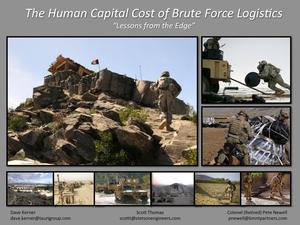Knowledge fuels change - Support energypedia!
For over 10 years, energypedia has been connecting energy experts around the world — helping them share knowledge, learn from each other, and accelerate the global energy transition.
Today, we ask for your support to keep this platform free and accessible to all.
Even a small contribution makes a big difference! If just 10–20% of our 60,000+ monthly visitors donated the equivalent of a cup of coffee — €5 — Energypedia would be fully funded for a whole year.
Is the knowledge you’ve gained through Energypedia this year worth €5 or more?
Your donation keeps the platform running, helps us create new knowledge products, and contributes directly to achieving SDG 7.
Thank you for your support, your donation, big or small, truly matters!
Lessons from the Edge
Lessons from the Edge
Presenter: Peter Newell, (BMNT Partners, USA)
Overview
Lessons learned by the Army in changing how it meets energy needs on the battlefield can well inform how energy solutions are brought to rural areas around the world.The high human cost of delivering energy on the battlefield led the Army to reexamine its assumptions about how energy is provided and used.Changing the way they framed the problem led to better energy solutions, saved lives, and made the missions more resilient.The resilience paradigm is also well suited to rural energy applications.Based on the Army’s lessons learned, the authors describe the attributes of a resilient system and discuss how these terms can be applied to instill energy resilience in rural communities[1].
Issues Presented
► Please see the presentation.
- Afghanistan, US Military
- Difficult to deliver supplies to rural bits
- Discovered that human capital expense was immense
- There was a lot of loss of goods, In addition to loss of human life
- Initially, people were resistant to idea of renewables as they were too heavy, unfamiliar, and not “trusted” on the ground, etc.. Thus making the case for renewables use took some time.
- Worked with groups outside of the US Govt
- Found that groups that were actually using the technologies, were the best to work with
- They deployed some great technologies that are very sustainable, and appropriate for outposts
- Reduction in exposure to combat
Q & A
1. How do you calculate the cost of a barrel of fuel?
- Its pretty immense ( in the thousands)
- The discussion of human capital seems to have changed the conversation in congress (as opposed to economics)
2. How much of the system was designed specifically for the application?
- They worked with a collection of suppliers and made slight modifications to civilian projects.
3. How can we learn from the military approaches (top down) and lots of capital for the rural applications (base of the pyramid)?
- The military approach was in large part informed by rural innovations. The aim is to make sure that the military doesn't have to compete for resources with the local communities, for water, fuel, etc.
4. What equipment will stay in Afghanistan, and will it be re-purposed for local communities?
- This is decided on a case by case basis and also depends on agreements with the host nation. Ultimately a decision is made by the state department, although a lot of other factors play into the decision.
References
- ↑ Lessons from the Edge. Peter Newell, David Kerner and Scott Thomas.





















